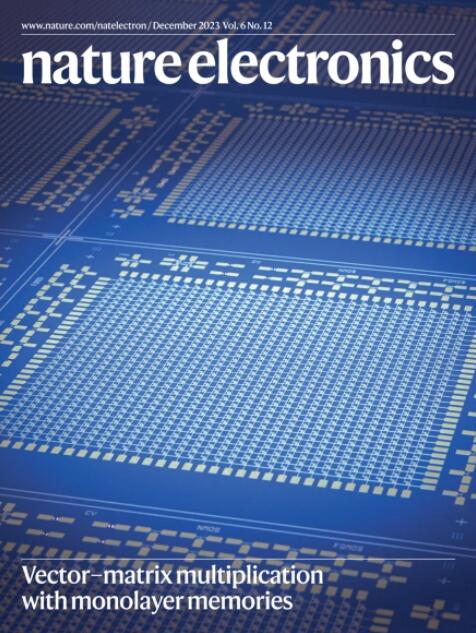采用具有原位物理不可克隆功能和真随机数生成器的记忆电阻器内存计算芯片进行联合学习
IF 40.9
1区 工程技术
Q1 ENGINEERING, ELECTRICAL & ELECTRONIC
引用次数: 0
摘要
联邦学习为多个参与者提供了一个框架,以便在保持数据隐私的同时共同训练神经网络,并且通常通过同态加密实现。然而,在局部边缘实现这种方法需要生成密钥、生成误差多项式和大量的计算,从而导致大量的时间和能量消耗。在这里,我们报告了一种记忆电阻器内存计算芯片架构,该架构具有用于密钥生成的原位物理不可克隆功能和用于错误多项式生成的原位真随机数生成器。我们的架构——包括一个竞争形成的阵列操作方法,一个基于内存计算的熵提取电路设计和一个基于冗余余数系统的编码方案——允许低错误率的计算,物理不可克隆函数和真随机数生成器在同一个忆阻器阵列和外围电路中实现。为了说明这种基于记忆器的联邦学习的功能,我们进行了一个案例研究,其中四名参与者共同训练一个具有482个权重的双层长短期记忆网络,用于脓毒症预测。在128kb忆阻器阵列上的测试精度仅比软件集中学习的测试精度低0.12%。与传统的数字联邦学习相比,我们的方法还显示出更少的能量和时间消耗。本文章由计算机程序翻译,如有差异,请以英文原文为准。


Federated learning using a memristor compute-in-memory chip with in situ physical unclonable function and true random number generator
Federated learning provides a framework for multiple participants to collectively train a neural network while maintaining data privacy, and is commonly achieved through homomorphic encryption. However, implementation of this approach at a local edge requires key generation, error polynomial generation and extensive computation, resulting in substantial time and energy consumption. Here, we report a memristor compute-in-memory chip architecture with an in situ physical unclonable function for key generation and an in situ true random number generator for error polynomial generation. Our architecture—which includes a competing-forming array operation method, a compute-in-memory based entropy extraction circuit design and a redundant residue number system-based encoding scheme—allows low error-rate computation, the physical unclonable function and the true random number generator to be implemented within the same memristor array and peripheral circuits. To illustrate the functionality of this memristor-based federated learning, we conduct a case study in which four participants cotrain a two-layered long short-term memory network with 482 weights for sepsis prediction. The test accuracy on the 128-kb memristor array is only 0.12% lower than that achieved with software centralized learning. Our approach also exhibits reduced energy and time consumption compared with conventional digital federated learning. A memristor-based architecture for federated learning can implement compute-in-memory technology for encryption and decryption computations, a physical unclonable function for key generation and a true random number generator for error polynomial generation all within the same memristor array and peripheral circuits.
求助全文
通过发布文献求助,成功后即可免费获取论文全文。
去求助
来源期刊

Nature Electronics
Engineering-Electrical and Electronic Engineering
CiteScore
47.50
自引率
2.30%
发文量
159
期刊介绍:
Nature Electronics is a comprehensive journal that publishes both fundamental and applied research in the field of electronics. It encompasses a wide range of topics, including the study of new phenomena and devices, the design and construction of electronic circuits, and the practical applications of electronics. In addition, the journal explores the commercial and industrial aspects of electronics research.
The primary focus of Nature Electronics is on the development of technology and its potential impact on society. The journal incorporates the contributions of scientists, engineers, and industry professionals, offering a platform for their research findings. Moreover, Nature Electronics provides insightful commentary, thorough reviews, and analysis of the key issues that shape the field, as well as the technologies that are reshaping society.
Like all journals within the prestigious Nature brand, Nature Electronics upholds the highest standards of quality. It maintains a dedicated team of professional editors and follows a fair and rigorous peer-review process. The journal also ensures impeccable copy-editing and production, enabling swift publication. Additionally, Nature Electronics prides itself on its editorial independence, ensuring unbiased and impartial reporting.
In summary, Nature Electronics is a leading journal that publishes cutting-edge research in electronics. With its multidisciplinary approach and commitment to excellence, the journal serves as a valuable resource for scientists, engineers, and industry professionals seeking to stay at the forefront of advancements in the field.
 求助内容:
求助内容: 应助结果提醒方式:
应助结果提醒方式:


